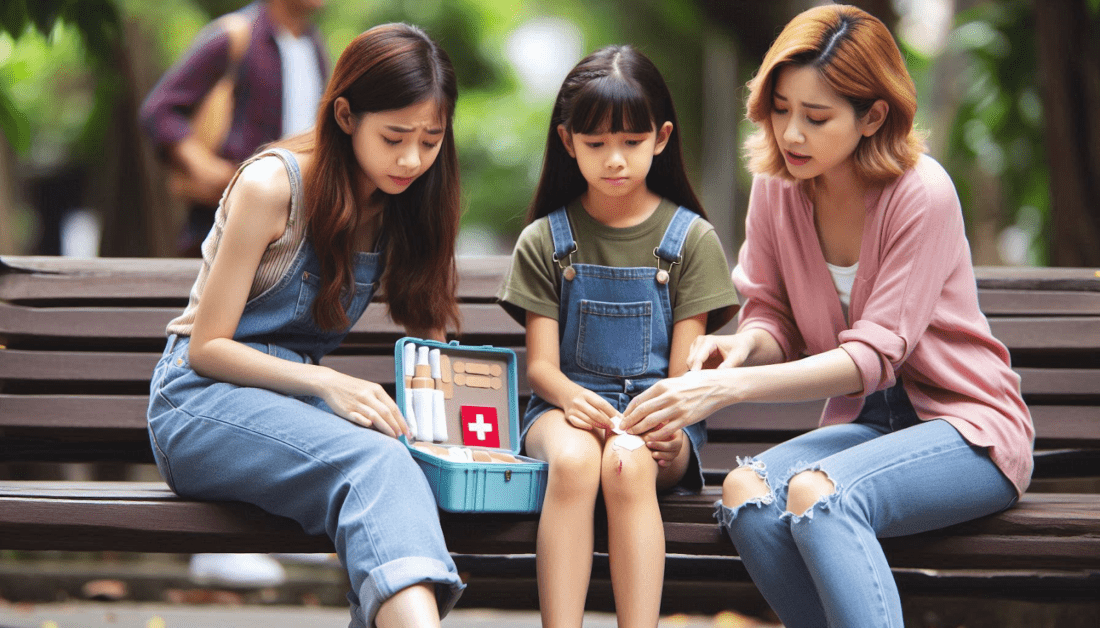Image: Created in MS Designer

Kids run around, play sports, and sometimes end up with bumps or bruises.
When childhood injuries happen at home, knowing how to handle them makes a huge difference. And, you don’t need a medical degree. Just some practical advice goes a long way.
From muscle strains to minor fractures, this guide helps you manage these common mishaps. Learn when first aid is enough and when to seek help.
Let’s make sure your child gets back on their feet quickly and safely!
Common Injuries During Playtime
Kids will be kids, and when out there doing what they do best – running, jumping, climbing – they often get hurt. Understanding the types of injuries that can happen helps you stay prepared.
- Cuts and scrapes
- Bruises
- Sprains
- Fractures
- Concussions
Knowing how to treat each injury is crucial. For cuts and scrapes, clean with mild soap and water. Use ice packs for bruises to reduce swelling. Sprains require rest and compression bandages. Minor fractures might need a splint until you reach professional help.
Pre-Emptive Care Solutions Online
Some injuries, depending on severity, often require more than just basic first aid. With the internet at your fingertips, thankfully, accessing professional advice and care has never been easier.
For instance, you can find detailed video tutorials for proper bandaging techniques or tips to recognize concussion symptoms early. Websites of certified healthcare providers now offer comprehensive physical therapy treatment, as well as guides that you can follow at home.
These include step-by-step instructions on exercises to improve mobility and reduce pain after a sprain or fracture. Utilizing these online resources ensures you’re well-equipped to handle minor injuries efficiently and seek help when necessary.
First Aid Essentials for Parents
What’s the very first thing to do when your child bumps into something and gets injured? Of course, that’s first aid, and you need a well-stocked kit for it. The kit should at the very least include the following:
- Adhesive bandages
- Antiseptic wipes
- Sterile gauze pads
- Tweezers
- Cold packs
These items handle most minor injuries. Adhesive bandages cover cuts while antiseptic wipes clean wounds to prevent infection. Gauze pads control bleeding, and tweezers remove small debris from cuts or scrapes. Cold packs reduce swelling from bruises or sprains.
And even with these in your arsenal, it pays to familiarize yourself with common first aid errors to avoid mistakes in these crucial moments.
Identifying Muscle Strains and Sprains
Your child’s playful antics might lead to a painful muscle strain or sprain – they’re quite common. Recognize the signs: swelling, bruising, pain during movement, or difficulty bearing weight.
Immediate actions include resting the injured part, applying ice for 20-minute intervals to reduce swelling, and using compression bandages for support.
Elevate the limb above heart level if possible. Over-the-counter pain relievers can help manage discomfort until you seek professional advice if symptoms persist.
When to Seek Medical Help Immediately
If your child experiences severe pain, heavy bleeding, or an inability to move a limb after an injury, don’t hesitate. These are red flags for serious issues like fractures or deep cuts that need urgent care.
Watch for signs of a concussion too: vomiting, confusion, or loss of consciousness. In these cases, head straight to the nearest emergency room or call emergency services for immediate professional intervention.
Ultimately, handling childhood injuries calmly ensures your child’s quick recovery. Being prepared and knowledgeable brings peace of mind, making you a confident caregiver in any situation.



